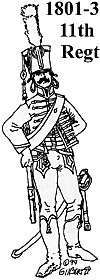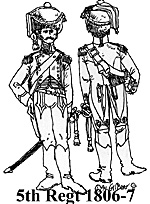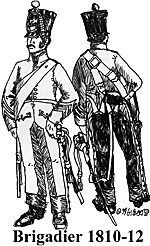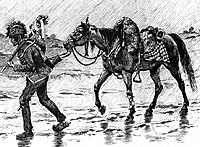 In EE&L #6 we looked at the
development of the Hussars in the
French army. The Chasseurs a Cheval
were of much later origin. Like the
hussars they came from the long line
of light troops that came to life in the
French army during the Wars of the
Polish Succession (1733-1738) and of
the Austrian Succession (1740- 1748).
In these wars, a multitude of small
units, often called Legions
were raised to engage in the small war
or petite guerre, in the
harassment of the enemy's
communications, raiding, etc., such
functions not at that time part of the
duties of the regular French cavalry.
In EE&L #6 we looked at the
development of the Hussars in the
French army. The Chasseurs a Cheval
were of much later origin. Like the
hussars they came from the long line
of light troops that came to life in the
French army during the Wars of the
Polish Succession (1733-1738) and of
the Austrian Succession (1740- 1748).
In these wars, a multitude of small
units, often called Legions
were raised to engage in the small war
or petite guerre, in the
harassment of the enemy's
communications, raiding, etc., such
functions not at that time part of the
duties of the regular French cavalry.
The Early History of the Chasseurs a Cheval Serving the French Monarchy
The first unit of Chasseurs a Cheval to be part of the French army appears to be the small band raised in 1733 under the name of Conti Chasseurs (Chasseurs de Conti). However, the real boom for such irregular light units was started in 1743, when a simple groom called Fisher got the authorization to raise one company of chasseurs for the little war.
A multitude of such units, of variable effectiveness, were to be raised in the following years. These Chasseurs and other light troops, part of the so-called Legions, were excellent soldiers but undisciplined and lawless when compared to the regulars. They were a mixture of light cavalry, indiscriminately called chasseurs, dragoons or hussars according to the taste of their owners, and light infantry also called by many names.
At end of the Seven Years War, to tame them, these undisciplined pillagers (yet veteran soldiers) were assigned to the new so-called Light Legions as part of the regular army. Each unit (Legions cites legeres ) was a mixture of light cavalry and light infantry and included I company of grenadiers, 7 of fusiliers and 8 of dragoons. These were the Legions of Conflans, Royale, Flandre, Hainaut, Clermont-Prince and Soubise. In 1766 Clermont-Prince became the Legion de Conde. In 1767, the dragoons of the Legion of Conflans became hussars. In 1768 Hainaut became the Legion de Lorraine and in 1769 a seventh Legion was raised: the Legion Corse which was renamed Dauphine in 1788.
An Ordnance dated March 25, 1776 disbanded these Legions, and their elements were incorporated into new units as follows: (1) The companies of horsemen of the Legion of Conflans became the regiment of Hussars of the same name which became the Hussars de Saxe in 1788.
(2) The 48 companies of Dragoons of the 6 other Legions were reorganized into 24 squadrons of Chasseurs a Cheval, each squadron becoming the 5th squadron of one of the existing 24 Dragoon regiments.
 That new combination of
Chasseurs a Cheval/Dragoons
brigaded in the same regiment was
of short duration. Three years later,
on January 20, 1779, a new ordnance
removed the Chasseurs a Cheval
squadrons from the regiments of
Dragoons and, for the first time
organized them in 6 regiments of
Chasseurs a Cheval. These new
regiments, contrary to the French
army tradition, did not take names but
were numbered from 1 to 6.
That new combination of
Chasseurs a Cheval/Dragoons
brigaded in the same regiment was
of short duration. Three years later,
on January 20, 1779, a new ordnance
removed the Chasseurs a Cheval
squadrons from the regiments of
Dragoons and, for the first time
organized them in 6 regiments of
Chasseurs a Cheval. These new
regiments, contrary to the French
army tradition, did not take names but
were numbered from 1 to 6.
Well, it appeared that, finally, the Chasseurs a Cheval were recognized as a new independent ann. Well not quite yet. The 1779 reorganization was also short lived. The memory of the Legions was still too strong and on May 8,1784, the mixed Legions were once more revived. Each regiment of Chasseurs a Cheval was brigaded with a battalion of foot Chasseurs (Chasseurs a pied). These 6 new mixed infantry-cavalry units were not called Legions but were given the name of mountains: Chasseurs des Alpes (1st regiment), Chasseurs des Pyrenees (2nd regiment), des Vosges (3rd regiment), des Cevennes (4th regiment), du Gevaudan (5th regiment), and des Ardennes (6th regiment).
These combined light regiments were of course of short duration again and in March 1788 these mixed chasseurs units were disbanded and the 6 Chasseurs a Cheval regiments were once again reorganized. Some of the foot Chasseurs were reorganized in separate battalions but that is another story. The King, certainly feeling guilty of so many changes, elected to give the new regiments the name of a province like that of the Light Infantry regiments, to certainly show their acceptance in the Royal Army. The Chasseurs a Cheval even got some kind of a revenge on the Dragoons, since in this year 6 regiments of Dragoons became Chasseurs a Cheval!
So on the eve of the Revolution, the Chasseurs a Cheval were finally recognized as a separate combat arm of 12 regiments.
The Uniform of the Chasseurs a Cheval Uniform before the Revolution
Until the 1780's, the Chasseurs a Cheval uniform was similar to that of the Dragoons. They were wearing the same helmet, boots, trousers etc. That state of affairs could not continue. Both arms had to be differentiated by a different uniform. It was out of question to give a new uniform to the 24 existing regiments of Dragoons which were a very distinctive arm with a solid, established tradition. Consequently, that of the new Chasseurs a Cheval had to be changed.
The new uniforms were regulated by the Ordnance of October 1st, 1786. It was far from arevolutionary ordnance but it started a necessary evolution which was to continue until the Reglement of 1812. The intention of the ordnance was clear, the Chasseurs a Cheval were some sort of light cavalry similar to the Hussars.
 Facing colors had already been
given to the Chasseurs a Cheval
regiments by the ordnance of 1779.
The new uniform kept the green infantry coat of the previous ordnance
but replaced the Dragoon helmet by
ablack lighterround hat. Then trousers
and boots are changed to the
Hungarian style, etc. but for reasons
of economy, the Dragoon saber and
musket with its bayonet were kept by
the Chasseurs a Cheval and their
armament completed by a pair of
pistols model 1777. The ordnance of
1778 stated that the Chasseurs were
to be equipped with a rifle.
Facing colors had already been
given to the Chasseurs a Cheval
regiments by the ordnance of 1779.
The new uniform kept the green infantry coat of the previous ordnance
but replaced the Dragoon helmet by
ablack lighterround hat. Then trousers
and boots are changed to the
Hungarian style, etc. but for reasons
of economy, the Dragoon saber and
musket with its bayonet were kept by
the Chasseurs a Cheval and their
armament completed by a pair of
pistols model 1777. The ordnance of
1778 stated that the Chasseurs were
to be equipped with a rifle.
The rifle or carabine de 1781, had a length of 1.432 meter, a barrel length of .93 meter and weighed approximately 4 kilograms (8.8 pounds). It was equipped with a bayonet model 1777 identical to that of the dragoons. No existing models of that weapon are known to exist.
The shabraque in sheep skin with the classical wolf teeth in the facing regimental color had been introduced by a previous ordnance but now was worn over the Hungarian type saddle identical to that of the Hussars without the Dragoon horse cloth.
The Evolution of the Chasseurs a Cheval Uniform during the Revolution and the Empire
In 1789, the Chasseurs a Cheval uniform was far from satisfactory. Their coat was still a modified version of the infantry coat and their headgear remained that of the Dragoons, not the hat of the 1786 ordinance. It was only in 1791 that the Minister of War, the Marechal de Camps Duportail, believed that he had finally found the ideal uniform for the Chasseurs a Cheval and presented his project to the National Assembly. The project was accepted and on April 1st 1791, a new regulation described the new uniform.
-
(1) The headgear was the Casque a chenille (a fur-crested Tarleton-style helmet) modified for the cavalry.
(2) The coat was be a long coat-dolman in green cloth, longer than that of the hussars. This new ordnance changed the previous facing colors, now to be of 4 colors: red (ecarlate), yellow (jonquille), pink and crimson by series of 3 regiments.
- Other colors were added: orange, sky blue and aurore in 1793; capucine in 1794; Madder red in 1801 followed by the amaranth and chamois in the Empire.
(3) The culottes was a culotte Hongroise also made of green cloth and complemented by the classical Hungarian boots piped in regimental colors.
Very quickly the new uniform became unpopular and in May 1795, the Military Committee adopted the hussar shako, recognizing a de facto situation since the regiments had already replaced the unpopular casque a chenille some time before. In addition to this "evolution," the long coat-dolman got shorter and shorter to finally end up as a hussar-length dolman and soon the sabretache and sash magically appeared in the ranks. Later on, a few regiments, like the 5th, 10th and 22nd, even adopted the pelisse of the Hussars. Our Chasseurs a Cheval looked more and more like the prestigious Hussars! The quest for the ultimate Chasseur a Cheval uniform was not yet ended.
As early as 1798, General Kellerman pointed out the fact that the Chasseurs a Cheval were more or less copying the Hussars uniform. No new ordnances concerning the Chasseurs a Cheval uniform were to be issued until l8l2. But in spite of that, some changes came slowly. The dolman and the pelisse were still wom but replaced in turn by a long- coat, the habitlong in turn replaced by the coat a la Kinski, a coat buttoned in the middle down to the waist by a row of 9 rounded tin buttons and piped the length of the breast in the regimental colors; this began to appear in 1808.
All the above coats were officially replaced by the ordnance of February 7,1812 which introduced the new habit-veste, a modified version of the coat a la Kinski. The origin of the coat a la Kinski, is a mystery.
It was similar to the coat a la Kinski except that it had lapels. The new 1812 habit-veste only appeared in the Chasseurs a Cheval regiments in 1813.
One should not conclude that these changes were introduced all at once and made from one year to the next. That is not so. These changes overlapped one another constantly.
Up to the Consulate, the Chasseur a Cheval uniform was essentially that described by the Regulation of April 1,1791. A shorted version of the original dolman was still worn with a shako. The dolman was made of dark green cloth (but not as dark as the cloth used during the Empire) with 3 rows of tin buttons and between 13 to 18 rows of braid. The number of rows vary from regiment to regiment. For instance the 11th Chasseurs dolman has 11 rows of braid and the 5th Chasseurs 15 rows.
It was worn during the parades and as a full dress uniform by all the regiments prior to 1805. In spite of the fact that the dolman was not regulation during the Empire many regiments continued to wear it on parade. The 11th regiment did so until 1811.
The long coat or habit-long prior to 1805-6 (a long tailed coat with lapels and tumbacks), worn mostly as an undress uniform or as field wear in the early Empire, progressively became the accepted full dress uniform for many regiments. The collar and cuffs, unlike the dolman, were not decorated with white lace but piped in the reverse colors. For instance a green collar would be piped red or scarlet, yellow collar piped white and red collar piped green.
The tumbacks were usually in the facing color and further decorated with a hoary. The piping on the lapels, shoulder-straps (if any) and imitation pockets were also in the regimental colors.
 Starting in 1808 the habit-long was slowly
replaced by the Kinski or habit a la Kinski in
many regiments and by 1812 this was practically the
standard Chasseur field uniform. It was replaced by the
habit-veste by the Reglement of 1812 which was
not implemented until 1813. So the Chasseurs a Cheval
made the Campaign of Russia with the habit a la
Kinski.
Starting in 1808 the habit-long was slowly
replaced by the Kinski or habit a la Kinski in
many regiments and by 1812 this was practically the
standard Chasseur field uniform. It was replaced by the
habit-veste by the Reglement of 1812 which was
not implemented until 1813. So the Chasseurs a Cheval
made the Campaign of Russia with the habit a la
Kinski.
The habit-veste was virtually identical to the habit a la Kinski except that it had lapels. Collars, piping, etc. were identical to that of the previous habit a la Kinski.
Our Chasseurs also wore a sleeveless waistcoat under their dolman, Kinski or habit-veste. It was to be white in the summer and green in the winter. That order was respected by 1813 but prior to that date, non-regulation variations were worn by some regiments. For instance the 11th Chasseurs in 1803-1804 wore a red waistcoat on parade. The crossbelts of the 5th and 27th Chasseurs were yellow.
Some regiments like the lst, 7th, 10th and 16th Chasseurs had their waistcoats decorated with lace in the fashion of the dolman. Sometimes these decorated waistcoats were in the facing colors. Some regiments wore a waist sash.
Beside the endless sorts of shakos that deserve a full article, the rest of the uniform remained unchanged with their Hungarian boots and culottes hongroises. While on campaign, the Chasseurs never wore the full dress uniform and their Hungarian trousers were covered by a green or gray overalls or Charivari identical to that of the Hussars (see EE&L #5, p. 61) or coarse riding- breeches, with the inner leg and cuffs reinforced with black leather. These overalls were fastened by 18 pewter or tin buttons on a regimental color trim.
The Chasseurs a Cheval uniform was completed by a green, sleeveless cavalry cape with a hood. The cape was replaced by a manteau trots-quart with sleeves but without hood. It was shorter than the cape but included a short shoulder cape fastened around the collar. The Reglement of 1813 introduced the manteau-capote with sleeves, buttoned in the front that also included a short shoulder cape.
The officers often wore a surtout as an undress uniform. It was similar to the habit-long except it was devoid of lapels and turnbacks. For foot duty, the officers also wore the green redingote, a full length, double breasted great coat with a collar in regimental color.
The Chasseur cartridge-case or giberne, crossbelt, musketoon-sling, saber waistbelt and sling were white. The white leather crossbelt, 3.15 inches (80mm) wide, was worn over the left shoulder. All the metal ornaments and buckles were of copper.
Until 1813 the trumpeters in theory wore the Imperial Livery. In fact the trumpeters usually wore nothing like that, but instead a uniform in reversed regimental colors. Again, an infinite number of variations can be found.
The Chasseurs, at least during the early Empire, used two types of swords. The sabre a la hussarde and the sabre a la chasseur. The sabre a la chasseur had a relatively shallow degree of curve while that of the hussar type had a more considerable curve. Both sabre types were progressively replaced by the Year XI light cavalry sabre.
So, in fact, we have to wait until 1813 to find our Chasseurs a Cheval with a uniform proper to that arm entirely different from that of the Hussars! In addition, prior to 1813, with all the overlapping and the complete disregard for dress regulations, it is impossible to speak of a typical Chasseur uniform.
Conclusion
We have briefly covered the history and the evolution of the Chasseurs a cheval in the French army as well as their uniforms. Our limited study is far from exhaustive. Many points have not been covered.
However, we hope our article with that on the Hussars set the stage to discuss the role of true Light Cavalry in the Wars of the Revolution and of the Empire in which the Chasseurs a cheval were raised to no less than 31 regiments and the Hussars some 14 regiments.
Color Uniform Plates (very slow: 277K)
| Chasseurs a Cheval Facing Colors Between January 1st 1791 and February 7 1812 | ||||
|---|---|---|---|---|
| FACING COLOR | GREEN COLLAR PIPING COLOR | COLLAR COLOR
PIPING COLOR | GREEN FACINGS GREEN PIPING | COLOR FACINGS
PIPING COLOR |
| Scarlet | 2nd | 1st and 3rd | 3rd | 1st and 2nd |
| Yellow | 5th | 4th and 6th | 6th | 4th and 5th |
| Pink | 8th | 7th and 9th | 9th | 7th and 8th |
| Crimson | 11th | 10th and 12th | 12th | 10th and 11th |
| Orange | 14th | 13th and 15th | 15th | 13th and 14th |
| Sky blue | 17th | 16th and 18th | 18th | 16th and 17th |
| Aurore | 20th | 19th and 21st | 21st | 19th and 20th |
| Capucine | 23rd | 22nd and 24th | 24th | 22nd and 23rd |
| Madder | 26th | 25th | - | 25th and 26th |
| IMPORTANT NOTE: It is unlikely that the chart above was followed to the
letter until 1812. It is likely that the facings colors published in the REGLEMENT
of 1812, (see table below) were used well before that date. The 17th and 18th
were disbanded in 1794 and only raised again in 1815. In addition, the 27th, 28th
and 29th were raised in 1808, the 30th in 1810 and the 31 st in 1811.
The principle outlined above was used with the facing colors madder red, amaranth and chamois for the new regiments. Was the principle followed to the letter? Not quite, one of the notable exception was the 27th Chasseurs, raised from the Chevau-legers beiges, which kept its green dolman with amaranth facings with copper buttons instead of the regulation habit a la Kinski green and madder red with | ||||
| Chasseurs a Cheval Facing Colors from February 7, 1812 | ||||
|---|---|---|---|---|
| REGIMENT | COLLAR | COLLAR PIPING | FACINGS | FACING PIPING |
| 1st | red | green | red | green |
| 2nd | green | red | red | green |
| 3rd | red | green | green | red |
| 4th | yellow | green | yellow | green |
| 5th | green | yellow | yellow | green |
| 6th | yellow | green | green | yellow |
| 7th | pink | green | pink | green |
| 8th | green | pink | pink | green |
| 9th | pink | green | green | pink |
| 10th | red | green | red | green |
| 11th | green | red | red | green |
| 12th | red | green | red | green |
| 13th | orange | green | orange | green |
| 14th | green | orange | orange | green |
| 15th | orange | green | green | orange |
| 16th | sky blue | green | sky blue | green |
| 17th | green | sky blue | sky blue | green |
| 18th | sky blue | green | green | sky blue |
| 19th | aurore | green | aurore | green |
| 20th | green | aurore | aurore | green |
| 21st | aurore | green | green | aurore |
| 22nd | capucine | green | capucine | green |
| 23rd | capucine | capucine | capucine | green |
| 24th | capucine | green | green | capucine |
| 25th | madder | green | madder | green |
| 26th | green | madder | madder | green |
| 27th | madder | vert | vert | madder |
| 28th | amaranth | green | amaranth | green |
| 29th | green | amaranth | amaranth | green |
| 30th | amaranth | green | green | amaranth |
| 31st | chamois | green | green | chamois |
| The above chart has been devised in 1812, but it certainly was in use before that date. It is unlikely that the War Administration (Administration General de la Guerre) did not publish anything on that matter between 1802 and 1812. | ||||
Sources
Uniformes, issues 30, 36, 37 and 48.
Bucquoy,Cdt, Les Unifonmes du Premier Empire.
Rousselot, Lucien Unifonm plates
Bukhari, Emir Napoleon's Chasseurs, Osprey Men-At-Arms Series, 1977.
Funcken, Liliane and Fred, L'uniforme et les Soldats du Premier Empire, Casterman, Paris, 1968.
Misc. notes some from French archives, etc.
Back to Empire, Eagles, & Lions Table of Contents Vol. 2 No. 9
Back to EEL List of Issues
Back to MagWeb Master Magazine List
© Copyright 1994 by Emperor's Headquarters
This article appears in MagWeb (Magazine Web) on the Internet World Wide Web.
Other military history articles and gaming articles are available at http://www.magweb.com
